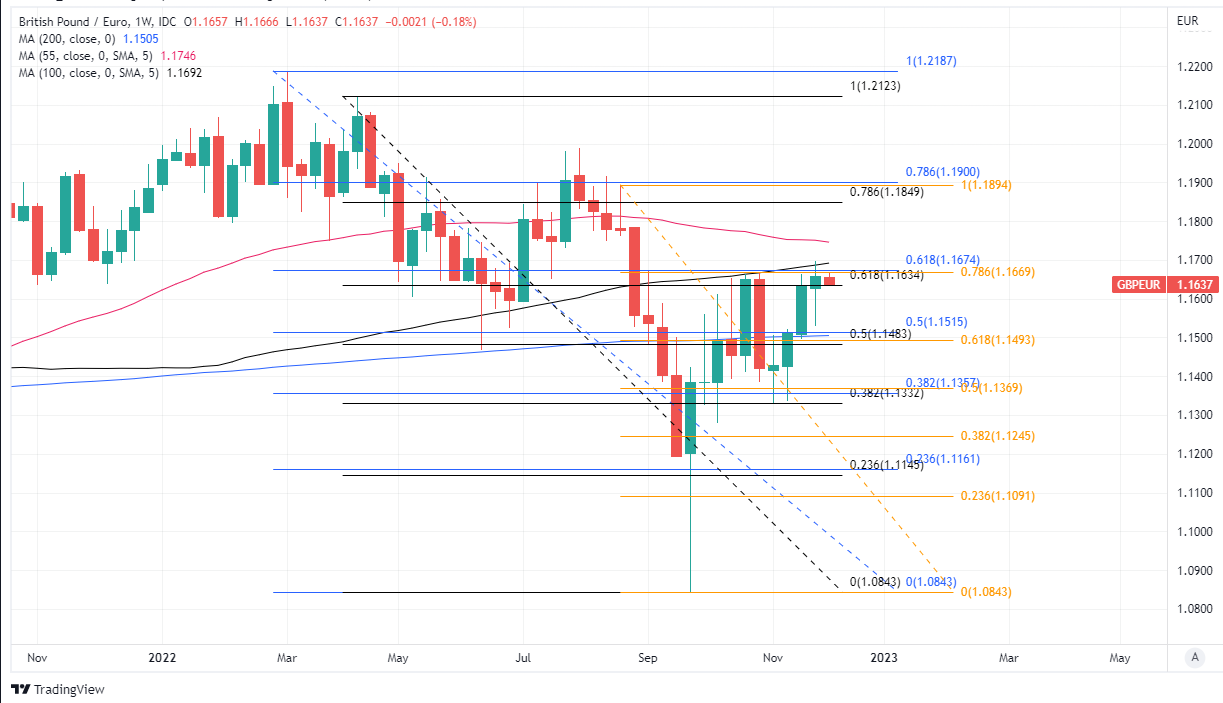GBP/EUR Week Ahead Forecast: Facing Obstacles on Charts
- Written by: James Skinner
-
- GBP/EUR meets resistance at 1.1669, 1.1674 & 1.1992
- But supported near 1.1601, 1.1592 & 1.1539 short-term
- Global factors drive amid dearth of data in UK & Europe

Image © Adobe Images
The Pound to Euro exchange rate's multi-month recovery was frustrated last week as Sterling became caught in a dense pocket of technical resistance, which could continue to obstruct the path higher in the days ahead and what is set to be a quiet period for UK and European economic calendars.
Sterling benefited last week when risky currencies were buoyed by a rallying Renminbi and the Dollar remained under pressure alongside U.S. government bond yields until Friday's release of the November non-farm payrolls report prompted each of these trends to partially reverse ahead of the weekend.
The Pound climbed by only a mere handful of points against the Euro, despite also rising broadly against other currencies during a week in which the limited output of the UK economic calendar offered little to inspire confidence in the outlook for Sterling.
"The latest money and credit data have made us more confident that households will be cautious when deciding whether to draw on their savings or to borrow more in order to support their real consumption," says Sanuel Tombs, chief UK economist at Pantheon Macroeconomics.
"Accordingly, spending looks set to fall almost as sharply as incomes in 2023, leading to a 1.5% year-over-year contraction in GDP," Tombs writes in a Monday research briefing while reiterating what is a below-consensus forecast for the UK economy next year.
Above: Pound to Euro rate shown at daily intervals with Fibonacci retracements of early October's extended rally and selected moving-averages indicating possible areas of technical support for Sterling. Click image for closer inspection.
Tombs said on Monday that last week's borrowing and lending data from the Bank of England (BoE) support his and Pantheon Macroeconomics' view that the Office for Budget Responsibility's (OBR) November forecasts for UK economic growth in the years ahead were overly optimistic.
"Its forecast for a swift recovery in GDP in 2024 depends on households reducing their saving rate sharply, and a smaller fall in employment than implied by its past relationship with GDP," he said in a November forecast summary.
The rising cost of mortgages stemming from the BoE's interest rate rises is likely to weigh heavily on household spending next year, Tombs and the Pantheon team forecast, in turn further undermining an economy already in recession due to the high and still-rising cost of energy.
Above: Pound to Euro rate shown at daily intervals with Fibonacci retracements of early October's extended rally and selected moving-averages indicating possible areas of technical support for Sterling. Click image for closer inspection. If you are looking to protect or boost your international payment budget you could consider securing today's rate for use in the future, or set an order for your ideal rate when it is achieved, more information can be found here.
"Indeed, we think that fiscal austerity measures recently announced by the UK government would exacerbate the ongoing UK recession. The latter could compromise the ability of the BoE to deliver on the still quite hawkish market expectations," says Valentin Marinov, head of FX strategy at Credit Agricole CIB.
There is little of consequence in either of the UK and European economic calendars for the week ahead, however, which is likely to leave the Pound beholden to international factors such as the trajectory of U.S. bond yields, the Dollar and stock markets.
This means U.S. data like Monday's release of the Institute for Supply Management (ISM) Services PMI for November and Friday's producer prices figures will be key influences on Sterling through their effect on U.S. bond yields and the Dollar.
Falling U.S. bond yields pulled the Dollar lower last week and lifted other currencies including Sterling as financial markets fixated on the Federal Reserve's (Fed) reminder that it's likely to lift interest rates in smaller increments than before over the coming months.
Above: Pound to Euro rate shown at weekly intervals with Fibonacci retracements of August, April and February downtrends indicating possible areas of technical resistance for Sterling. Click image for closer inspection. To optimise the timing of international payments you could consider setting a free FX rate alert here.
However, there is a lingering risk of a protracted policy cycle in which borrowing costs are ultimately lifted higher than markets currently expect due to a resilient U.S. economy and slow progress in returning inflation to the 2% target, and this week's U.S. data could potentially serve as a reminder of that.
"Indeed, our economists expect the Fed policy rates to hit 5.25% in 2023. The FOMC can signal the move by upwardly revising its dot-plot at its 14 December policy meeting. The inflation and labour market data out of the US due this week could prepare the ground for the Fed signal," Credit Agricole's Marinov warns
Falling yields were supportive of Sterling last week and so any rebound over the days ahead would potentially induce fresh weakness in the Pound to Euro rate, although much about price action this week also likely depends on the financial market response to developments in China.
"China’s President Xi was reported to have downplayed the seriousness of the current covid strain.If true, markets will be buoyed by the prospect of China re-opening its economy. A growing number of Chinese cities are easing restrictions," says Joseph Capurso, head of international economics at Commonwealth Bank of Australia.














